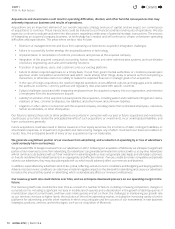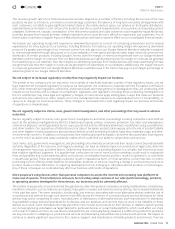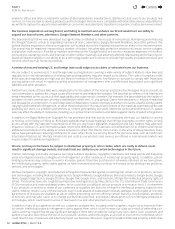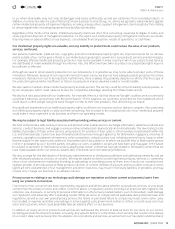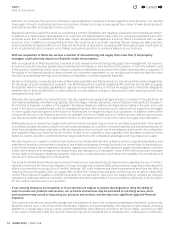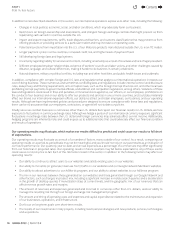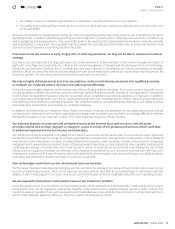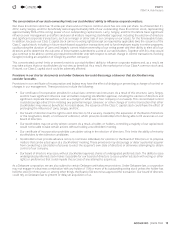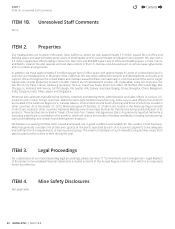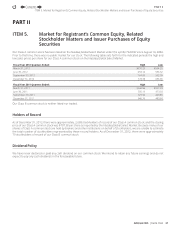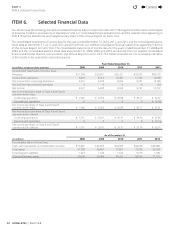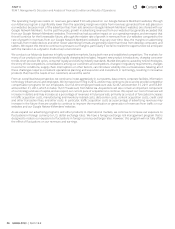Google 2012 Annual Report Download - page 22
Download and view the complete annual report
Please find page 22 of the 2012 Google annual report below. You can navigate through the pages in the report by either clicking on the pages listed below, or by using the keyword search tool below to find specific information within the annual report.
16 GOOGLE INC. | Form10-K
PART I
ITEM1A.Risk Factors
In addition to risks described elsewhere in this section, our international operations expose us to other risks, including the following:
•Changes in local political, economic, social, and labor conditions, which may adversely harm our business.
•
Restrictions on foreign ownership and investments, and stringent foreign exchange controls that might prevent us from
repatriating cash earned in countries outside the U.S.
•
Import and export requirements, tariff s, trade disputes and barriers, and customs classifi cations that may prevent us from
off ering products or providing services to a particular market and may increase our operating costs.
•
Potential injunctions from importation into the U.S. of our Motorola products manufactured outside the U.S. in an ITC matter.
•Longer payment cycles in some countries, increased credit risk, and higher levels of payment fraud.
•Still developing foreign laws and legal systems.
•
Uncertainty regarding liability for services and content, including uncertainty as a result of local laws and lack of legal precedent.
•
Diff erent employee/employer relationships, existence of workers’ councils and labor unions, and other challenges caused by
distance, language, and cultural diff erences, making it harder to do business in certain jurisdictions.
•Natural disasters, military or political confl icts, including war and other hostilities, and public health issues and outbreaks.
In addition, compliance with complex foreign and U.S. laws and regulations that apply to our international operations increases our
cost of doing business. These numerous and sometimes confl icting laws and regulations include internal control and disclosure
rules, data privacy and fi ltering requirements, anti-corruption laws, such as the Foreign Corrupt Practices Act, and other local laws
prohibiting corrupt payments to governmental o cials, and antitrust and competition regulations, among others. Violations of these
laws and regulations could result in fi nes and penalties, criminal sanctions against us, our o cers, or our employees, prohibitions on
the conduct of our business and on our ability to off er our products and services in one or more countries, and could also materially
aff ect our brand, our international expansion eff orts, our ability to attract and retain employees, our business, and our operating
results. Although we have implemented policies and procedures designed to ensure compliance with these laws and regulations,
there can be no assurance that our employees, contractors, or agents will not violate our policies.
Finally, since we conduct business in currencies other than U.S. dollars but report our fi nancial results in U.S. dollars, we face
exposure to fl uctuations in currency exchange rates. Although we hedge a portion of our international currency exposure, signifi cant
fl uctuations in exchange rates between the U.S. dollar and foreign currencies may adversely aff ect our net income. Additionally,
hedging programs are inherently risky and could expose us to additional risks that could adversely aff ect our fi nancial condition
and results of operations.
Our operating results may fl uctuate, which makes our results diffi cult to predict and could cause our results to fall short
of expectations.
Our operating results may fl uctuate as a result of a number of factors, many outside of our control. As a result, comparing our
operating results on a period-to-period basis may not be meaningful, and you should not rely on our past results as an indication of
our future performance. Our quarterly, year-to-date, and annual expenses as a percentage of our revenues may diff er signifi cantly
from our historical or projected rates. Our operating results in future quarters may fall below expectations. Any of these events
could cause our stock price to fall. Each of the risk factors listed in this section in addition to the following factors may aff ect our
operating results:
•Our ability to continue to attract users to our websites and satisfy existing users on our websites.
•Our ability to monetize (or generate revenues from) tra c on our websites and our Google Network Members’ websites.
•Our ability to attract advertisers to our AdWords program, and our ability to attract websites to our AdSense program.
•
The mix in our revenues between those generated on our websites and those generated through our Google Network and
other factors, such as changes in product mix, including a signifi cant increase in mobile search queries and a deceleration
in the growth of desktop queries if monetization stays at current levels, and the geographic mix of our revenues that can
aff ect revenue growth rates and margins.
•
The amount of revenues and expenses generated and incurred in currencies other than U.S. dollars, and our ability to
manage the resulting risk through our foreign exchange risk management program.
•
The amount and timing of operating costs and expenses and capital expenditures related to the maintenance and expansion
of our businesses, operations, and infrastructure.
•Our focus on long-term goals over short-term results.
•
The results of our investments in risky projects, including new business strategies and new products, services, technologies
and acquisitions.
Contents
44






